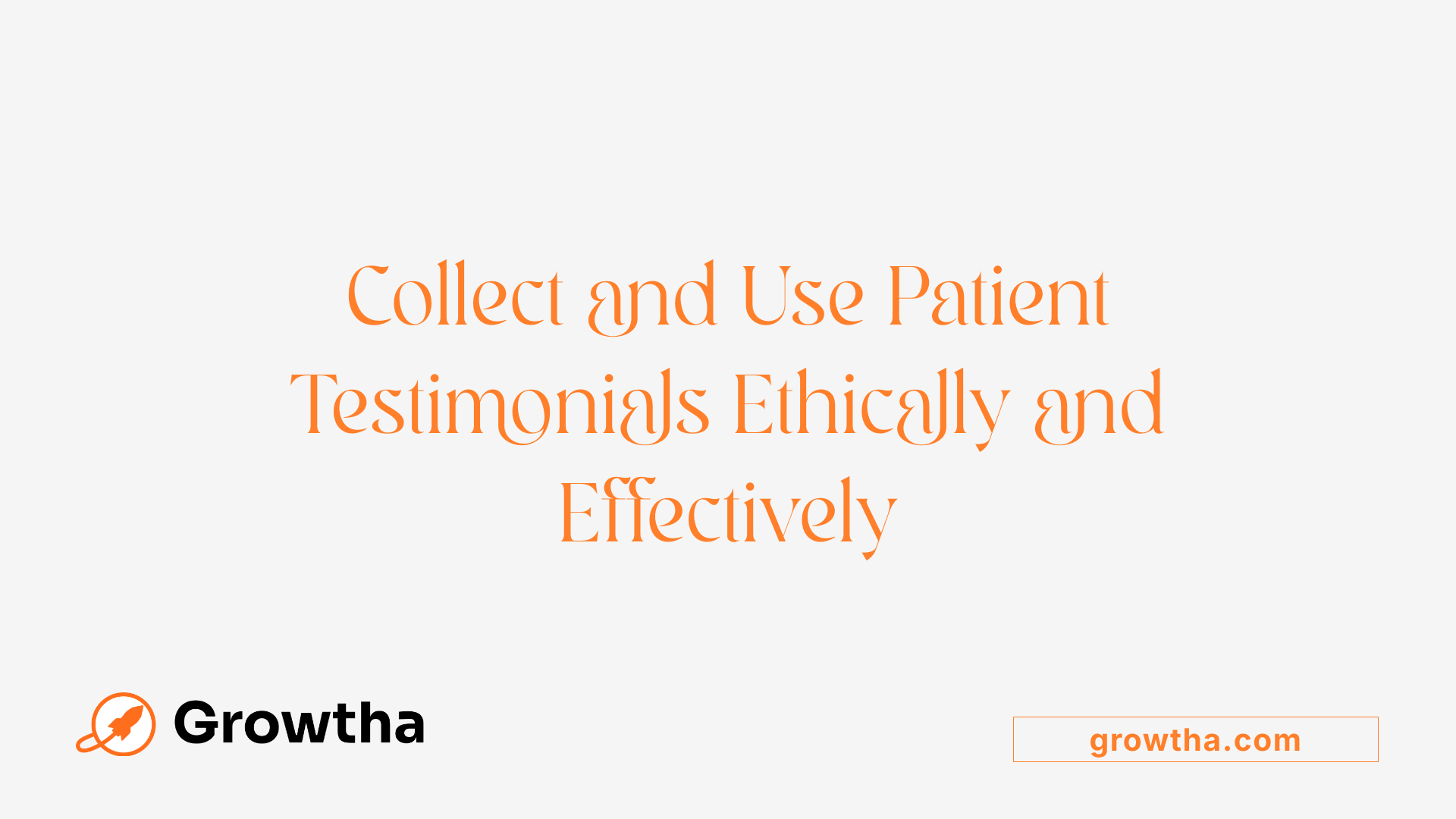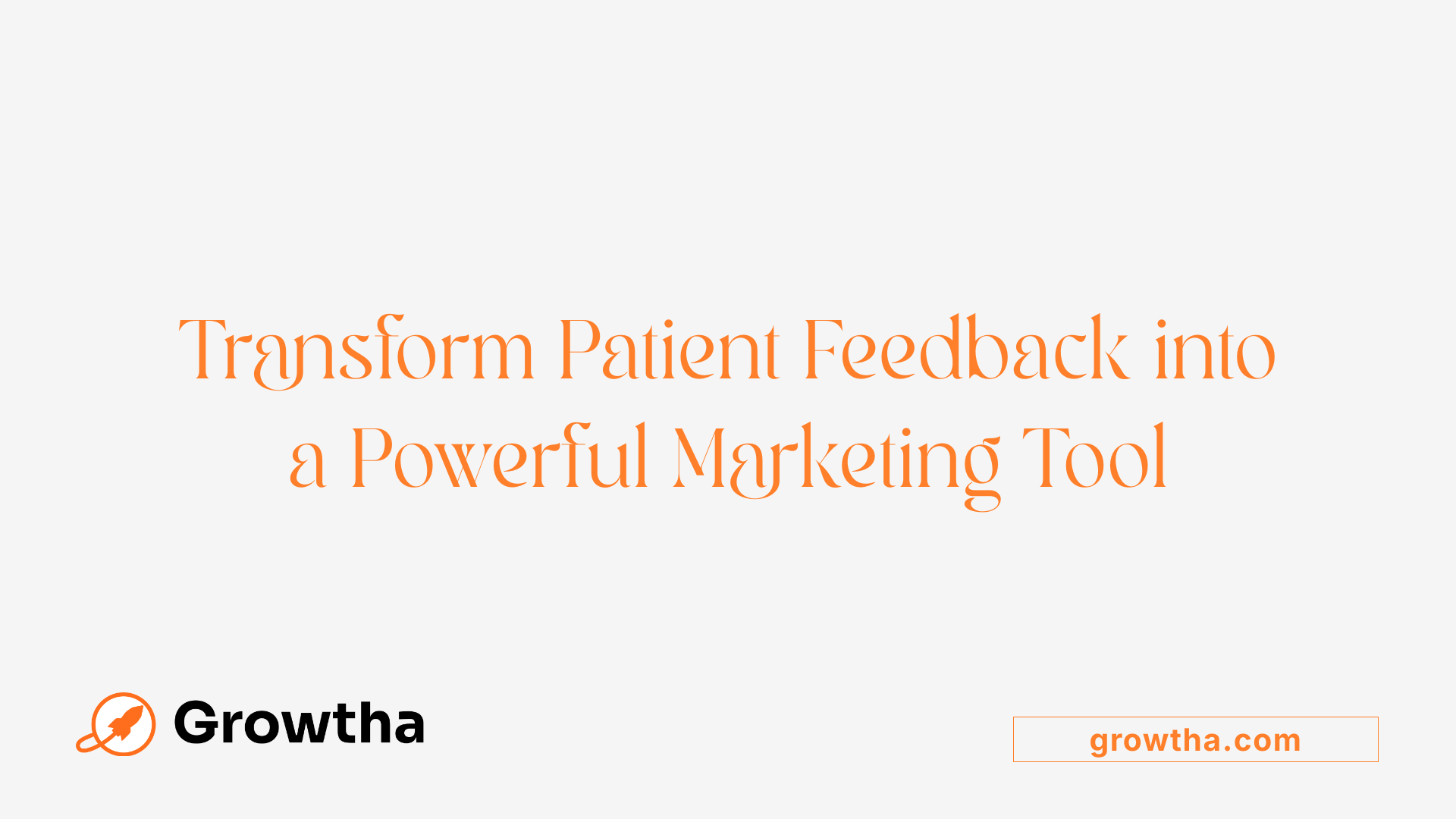How to Leverage Patient Testimonials for SEO
Harnessing Patient Stories to Boost Healthcare SEO


How to Leverage Patient Testimonials for SEO
Maximizing the Power of Testimonials for Digital Success
Patient testimonials are more than just positive feedback; they are a strategic asset in healthcare marketing. When leveraged correctly, they can substantially improve your online visibility, foster trust, and drive practice growth. This comprehensive guide explores how healthcare providers can effectively utilize patient stories to enhance their SEO efforts, build reputation, and attract new patients.
Understanding the Impact of Patient Testimonials on SEO and Trust

How do testimonials influence search engine rankings?
Patient testimonials are more than just praise; they are powerful tools that can significantly boost a healthcare provider’s visibility online. Search engines prioritize fresh, relevant content—user reviews and testimonials are a continual stream of authentic information that search engines recognize as indicators of an active, trustworthy site.
When these testimonials include keywords related to specific services, locations, or conditions, they improve the site's relevance in local search results. Embedding verified reviews into dedicated pages with schema markup enhances their discoverability and presentation on search results pages, such as in rich snippets. Regularly updating testimonials signals ongoing activity, encouraging better indexing and higher ranking.
How do testimonials help build trust and credibility with patients?
Authentic patient stories foster a genuine emotional connection with prospective patients. Sharing real experiences humanizes the practice, showcasing not only clinical expertise but also compassionate care. This social proof reassures potential patients that they are choosing a reputable provider.
Testimonials instill confidence by illustrating successful outcomes, alleviating anxieties, and demonstrating transparency. They serve as endorsements—endorsed by actual patients—that support the practice’s reputation online, ultimately influencing decision-making and increasing patient loyalty.
What emotional connection do patient stories create?
Patient testimonials evoke strong emotional responses by sharing personal journeys, struggles, and triumphs. They tap into psychological triggers such as hope, fear, and reassurance, making the message more memorable.
For instance, a heartfelt story of overcoming dental anxiety or a successful rehabilitative treatment can inspire trust and empathy. Visual elements like patient photos and videos amplify this effect, making the stories more relatable and compelling.
How can testimonials enhance website content and SEO?
Integrating testimonials into your digital marketing strategy involves multiple approaches:
- Authentic storytelling: Using detailed narratives and real quotes that naturally include target keywords.
- Video testimonials: Embedding videos increases engagement time and dwell time, positively impacting search rankings.
- Dedicated testimonial pages: These pages, optimized with relevant keywords and structured data, attract search traffic seeking reviews.
- Schema markup: Implementing review schema helps search engines understand testimonial content for better indexing.
- Consistent updates: Fresh testimonials keep content current, signaling activity to search engines and enhancing rankings.
- Transcripts: Providing accurate transcripts of video testimonials with appropriate keywords further improves SEO and accessibility.
How does leveraging reviews and testimonials support broader marketing goals?
Sharing patient feedback across multiple channels—websites, social media platforms, emails, and review sites—amplifies reach and credibility. Positive reviews boost local SEO by increasing your online reputation and visibility on platforms like Google My Business and Yelp.
Using reviews in advertising campaigns, such as Google Ads and Facebook Ads, adds authenticity that can increase conversions. Responding promptly to reviews demonstrates excellent customer care, building trust and encouraging more feedback.
What are best practices for collecting and using patient testimonials ethically?
- Obtain explicit consent: Always ensure patients agree explicitly before sharing their stories.
- Maintain privacy: Comply with HIPAA and other privacy regulations.
- Encourage authenticity: Ask open-ended questions and avoid scripting responses.
- Diversify formats: Use written quotes, videos, and third-party reviews across platforms.
- Update regularly: Keep testimonial content fresh and relevant.
How can technology streamline testimonial management?
AI-powered tools and CRM systems facilitate efficient collection, curation, and deployment of testimonials. Automated prompts after appointments, sentiment analysis, and response management help maintain a steady flow of authentic reviews.
By strategically showcasing patient stories, healthcare providers can enhance trust, boost SEO, and ultimately attract more patients.
Effective Collection and Ethical Use of Patient Testimonials

Methods for collecting genuine patient feedback
Collecting authentic patient testimonials begins with establishing straightforward and respectful methods. Healthcare providers can utilize follow-up emails after appointments to invite patients to share their experiences. In-person requests during consultations often yield detailed feedback, especially when patients feel valued and heard. Encouraging detailed, honest, and natural responses can lead to more compelling stories. Utilizing online survey tools that include open-ended questions helps gather rich narratives and varied perspectives.
Moreover, offering templates or prompts can guide patients to share specific aspects of their journey, such as their initial concerns, treatment process, and results. Capturing multimedia content like photos or videos adds depth and credibility to testimonials, increasing engagement. It's also beneficial to incorporate feedback mechanisms within patient portals or through SMS campaigns, making participation convenient and accessible.
Ensuring compliance with HIPAA and privacy laws
Maintaining patient privacy and adhering to legal standards such as HIPAA is paramount when collecting testimonials. This involves securing explicit consent from the patient before sharing any identifiable information publicly. Healthcare providers should inform patients about how their stories will be used, obtained through clear documentation. Implementing policies that protect the confidentiality of health information ensures compliance.
Using secure channels for communication and storage of testimonial data further mitigates privacy risks. Staff training on confidentiality, along with regular audits of testimonial collection processes, helps uphold legal standards. Ensuring that no identifying details are disclosed without consent is essential, as is managing the security of multimedia content like videos and images.
Obtaining explicit consent and documentation
Explicit written consent is a critical step in the testimonial process. This can be achieved through a testimonials-specific consent form that details how the patient’s story will be used across platforms such as websites, social media, and marketing materials. The form should specify whether the testimonial will include personal details, photos, videos, or other identifiable information.
Documentation of consent should be maintained securely in the patient’s record, with clear flags or notes indicating permission has been granted. Open-ended consent forms that allow patients to specify what they are comfortable sharing are recommended. Patients should be informed of their right to withdraw consent at any time, and procedures should be in place to promptly remove or update testimonials upon request.
What regulatory considerations should be taken into account when using patient testimonials for SEO?
When leveraging patient testimonials for SEO, it is essential to adhere to stringent regulatory standards. Firstly, compliance with privacy laws like HIPAA is crucial; this means obtaining explicit, written consent through proper documentation such as a Notice of Privacy Practices and a testimonial authorization form. All testimonials should reflect truthful, genuine experiences supported by reliable evidence, avoiding any deceptive or misleading claims. It's important to disclose any material connections, including financial payments or incentives, to preserve transparency.
Respecting patient privacy is mandatory; this involves ensuring that consent clearly covers specific usage intentions across media channels. Consent forms should clarify the scope of sharing, including online and offline platforms. Additionally, following Federal Trade Commission (FTC) guidelines on endorsements helps maintain honesty by avoiding exaggerated claims and false impressions. This regulatory vigilance not only protects the practice legally but also builds trust with current and prospective patients.
Strategies for Optimizing and Showcasing Testimonials for SEO

How can healthcare providers create dedicated testimonial pages with relevant keywords?
Creating dedicated testimonial pages is a crucial step in maximizing the SEO potential of patient feedback. These pages should be optimized with targeted keywords that prospective patients might use when searching for healthcare services, such as
Leveraging Testimonials to Build Trust and Enhance Reputation

What is the role of patient testimonials in building trust and reputation online?
Patient testimonials play a vital role in establishing a healthcare practice’s credibility and trustworthiness on the web. They serve as authentic endorsements from real patients, providing social proof that the care offered is effective and compassionate. Such feedback not only showcases positive patient experiences but also humanizes the practice, making it more relatable and approachable for prospective patients.
Sharing various formats of testimonials—including written quotes, engaging video stories, and detailed case studies—helps appeal to diverse audiences and platforms. Videos and images create emotional connections that words alone might not achieve, making testimonials more persuasive and memorable.
Given that roughly 95% of consumers read online reviews before choosing a healthcare provider, testimonials significantly influence decision-making. They help patients reduce hesitation, confirm quality, and feel reassured that they will receive attentive care. In doing so, testimonials affirm the practice’s reputation and demonstrate a genuine commitment to patient satisfaction. This trust-building aspect is crucial in competitive healthcare markets where reputation can make or break a practice.
Turning Testimonials into a Marketing and SEO Asset

How can healthcare providers leverage patient testimonials and reviews to improve online visibility and search rankings?
Healthcare providers can effectively turn patient testimonials and reviews into powerful marketing and SEO tools by several strategic methods. First, incorporating relevant keywords naturally within testimonials and review content helps search engines recognize the relevance of the content to specific services or locations. Using schema markup—structured data embedded on websites—enhances how reviews appear in search results, making star ratings and snippets more prominent.
Displaying authentic testimonials on high-authority platforms like Google My Business, Facebook, and health review sites boosts local SEO by increasing the volume of positive, relevant content associated with the practice. Regularly collecting reviews through automated tools or follow-up emails ensures a steady stream of diverse, recent feedback. Prompt, professional responses to reviews demonstrate active engagement, build trust, and encourage more patients to leave feedback.
Showcasing testimonials across various channels—website pages, social media platforms, and marketing materials—amplifies their reach and impact. Ensuring compliance with HIPAA regulations and obtaining explicit patient consent safeguards privacy while leveraging these stories effectively. Collectively, these actions reinforce the practice’s credibility, improve search rankings, and attract new patients.
What techniques can be used to optimize patient testimonials to attract new patients and increase engagement?
Optimizing patient testimonials involves creating compelling narratives that feel authentic and relatable. Writing testimonials in patients’ own words, emphasizing real experiences and outcomes, fosters trust. Incorporating relevant keywords within testimonials and associated content helps boost visibility during searches for specific procedures.
Enhancing engagement also depends on the website’s usability. Ensuring the site is mobile-friendly and easy to navigate helps users find testimonials effortlessly. Using multimedia elements—such as videos and photos—makes testimonials more engaging and trustworthy.
Placing testimonials strategically on high-traffic pages, such as homepage banners, dedicated review pages, and service-specific sections, maximizes their exposure. Responding to reviews, especially negative ones, with professionalism shows active care and encourages ongoing dialogue. Leveraging word-of-mouth referrals from satisfied patients and running targeted advertising campaigns featuring testimonials can further attract new patients.
Adding call-to-action prompts within testimonials or review requests can guide visitors to schedule consultations or inquire further. These combined tactics cultivate a dynamic, trustworthy online presence that draws in new patients and fosters ongoing engagement.
Quantitative Benefits and Continuous Improvement of Testimonials

What are the benefits of leveraging patient testimonials for healthcare practice growth and online reputation management?
Harnessing patient testimonials offers significant advantages in expanding a healthcare practice’s reach and strengthening its reputation. Authentic stories serve as social proof, reassuring prospective patients and encouraging them to choose the practice. By showcasing real patient experiences, testimonials humanize healthcare delivery, creating emotional bonds that motivate ongoing engagement and referrals.
Effective testimonials also enhance online visibility, especially when collected ethically and presented strategically across digital platforms. This approach not only improves trustworthiness but also boosts search engine rankings through fresh, keyword-rich content. When diverse patient stories are featured, they demonstrate the practice’s commitment to inclusivity and quality care.
Tracking the influence of testimonials allows practices to evaluate their contribution directly. Metrics such as increased website traffic, higher engagement rates, and rising conversion levels indicate successful reputation building. Continual analysis helps refine testimonial strategies, ensuring long-term growth. Collectively, these efforts create a virtuous cycle where positive patient experiences fuel further practice development and solidify online authority.
How can providers measure the impact of patient testimonials on SEO and patient acquisition?
To assess how patient testimonials influence SEO and attract new patients, providers should monitor several measurable indicators. Website analytics tools enable tracking of traffic sources, user engagement, and time spent on testimonial pages. An increase in dwell time and lower bounce rates suggest that visitors find testimonials compelling and trustworthy.
Search rankings for relevant local keywords and visibility in Google Maps often improve as a result of consistent testimonial updates and positive reviews. Key performance indicators (KPIs) such as improvements in local search result positions or higher rankings in relevant searches demonstrate enhanced search engine optimization.
The volume and sentiment of reviews also matter. An upward trend in the number of reviews and positive feedback underpins a healthier online reputation. Comparing data from before and after testimonial campaigns reveals the tangible effects on practice visibility. This comprehensive measurement approach ensures strategies are data-driven and effectively targeted.
Tracking effectiveness through KPIs and analytics
Practices should establish specific KPIs to evaluate testimonial success. These include:
| KPI | Description | Example Metrics |
|---|---|---|
| Website Traffic | Visits originating from testimonial pages | Increase in visitors after testimonial campaigns |
| Engagement Metrics | User interaction with testimonial content | Average time on page, scroll depth |
| Conversion Rate | Visitors taking desired actions | Appointment bookings, contact form submissions |
| Local Search Rankings | Visibility in local search results | Rankings for service-specific keywords |
| Review Volume & Sentiment | Quality and quantity of reviews | Number of new reviews, sentiment score |
Digital analytics tools like Google Analytics, review management software, and SEO monitoring platforms help in tracking these data points. Regular dashboard reviews enable teams to identify patterns and adjust tactics accordingly.
Regular content updates and performance review
Maintaining fresh and relevant testimonials is vital for continuous SEO and reputation enhancement. Scheduling periodic collection of new reviews and success stories keeps the content current and engaging.
Content audits help ensure testimonials remain authentic, compliant, and aligned with branding standards. Incorporating new patient stories into blogs, social media, and review summaries boosts visibility and relevance.
Moreover, ongoing performance reviews involve analyzing KPIs, comparing against benchmarks, and gathering stakeholder feedback. These insights guide strategy adjustments, such as prompting satisfied patients for new testimonials or refining placement on digital channels.
By embedding an iterative process of collection, analysis, and update, healthcare practices can leverage testimonials as a dynamic tool that supports sustained growth, improved SEO rankings, and a trusted online presence.
Harnessing Testimonials for Long-term Success
Integrating patient testimonials into your healthcare marketing strategy is a powerful step toward boosting your online presence, enhancing trust, and realizing growth. By adhering to best practices in collection, compliance, and presentation, and leveraging innovative tools and content formats, healthcare providers can not only improve search rankings but also forge stronger emotional connections with prospective patients. Regularly updating testimonials and monitoring their impact ensures sustained relevance and effectiveness, turning patient stories into a cornerstone of your practice’s digital success.
References
- How to Utilize Patient Testimonials in Your Digital Marketing Strategy
- How to Leverage SEO to Drive Patient Acquisition and Satisfaction
- The Power of Patient Testimonials in Health and Wellness Marketing
- Leveraging Reviews and Testimonials for SEO - Digital Resource
- What are some effective ways to leverage customer reviews and ...
- Leveraging Patient Testimonials and Reviews for Practice Growth
- How to leverage customer reviews for better SEO rankings
- Leveraging Patient Testimonials for Practice Growth
- The Power of Patient Testimonials in Healthcare Marketing







